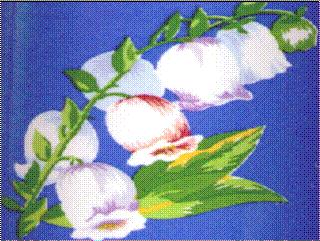Muguet
You may not recognise the name immediately unless you are a French speaker Muguet is Lily of the Valley to us English speakers.
Why didn't we just say Lily of the Valley then? - this is because
most of the Lily family are large flowers with no odour at all, and the remainder do not display a common odour characteristic. We have found that when the term Lily of the Valley is used then streams of questions arise about the other Lilies - fragrance wise, there is no connection.

The delicate sweet odour of Muguet has no equal. It is elegant and sophisticated but still lively and fresh, there is none of the heavyness associated with the narcotic florals. I can do no more justice to the fragrance of Muguet than John Lawrence, who wrote almost 300 years ago:
Analysis of the chemical composition of Muguet reveals to us that the main components are the rose alcohols Citronellol, Geraniol, Nerol and their esters, Phenyl Ethyl Alcohol and Linalool, Indol, traces of cis-3-Hexenol and its esters . However, these materials simply give us a rosy odour base from which to work from and do not explain the the sophistication of the odour. Synthetics with no natural equivalents come into play here and it is Hydroxycitronellal that is traditionally the most representative of the Muguet odorants. In compounds we can frequently find up to 40% of Hydroxycitronellal. More recently developed aroma chemicals have added to the palette of the perfumer such as Lilial - Givaudan-Roure, Lyral - IFF, Dupical - Quest, Mayol - Firmenich. It is these materials that usually form the basic structure of the Muguet fragrance. The rose alcohols act as a combination of blenders/modifiers. Muguet flowers display a natural greeness which is frequently replicated using cis-3-Hexenol, cis-3-Hexenyl Benzoate and this greeness can be modified with Phenyl Acetaldehyde and traces of Galbanum notes.
The fragrance can be blended and smoothed with the use of Linalool and Tepineol, the latter used carefully adds depth and power but overuse gives a lilac/pine character. Hedione, Helional, Cyclamen Aldehyde are useful blending agents for Muguet.
Fixatives for Muguet include Indol which gives depth without undue sweetness. Traces of Civet Extract (a lot less than 1%) help to give a natural effect. Macro and polycyclic musks are useful. Lyral and Dupical both have excellent tenacity and can be increased to act as fixatives.
.
|
||||||||||||||||||||||||||||||||||||
Modifiers
|
||||||||||||||||||||||||||||||||||||
Blenders
|
||||||||||||||||||||||||||||||||||||
Fixatives
|
||||||||||||||||||||||||||||||||||||
Novel Effects
|
| Hydroxycitronellal
Citronellol Lyral Lilial Phenyl Ethyl Alcohol Linalool Terpineol Cyclamen Aldeyde cis-3-Hexenol Helional Indol Civet Fleuressence Phenyl Acetaldehyde Dimethyl Acetal Rose de Mai Absolute |
40.00
10.00
5.00
8.00 18.00 12.00 3.00 1.00 0.30 1.70 0.20 0.10 0.50 0.20 |
| . |
100.00
|